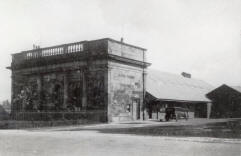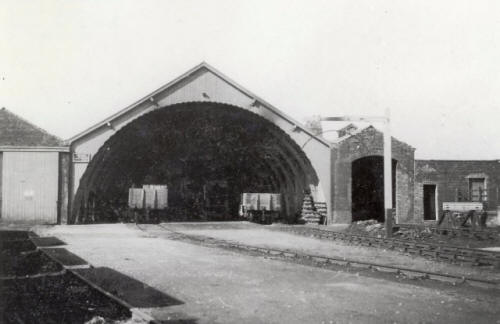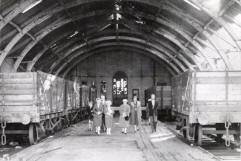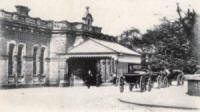Early Coast Travel
"Early Coast Travel", by Roy V. Hughes, L.M.S. Magazine, February 1931.
 The ornate stone building in Station
Road was the original passenger station, and was a terminus. The coast line
from Blackpool to Lytham was not opened till 1862, and the Station Road
building was then transformed into a goods depot. The ornate stone building in Station
Road was the original passenger station, and was a terminus. The coast line
from Blackpool to Lytham was not opened till 1862, and the Station Road
building was then transformed into a goods depot.
When the railway came to Lytham it came to stay. The solid-cut
attractive little old passenger station of the Preston and Wyre Railway is a
monument to the faith of our pioneers in this new idea—the railway—that was
sweeping the world. It is a pity—a minor tragedy —that this station was made a
terminus, for progress soon demanded an extension of the line, and the town's first
station was left, semi-derelict, as a goods warehouse at the end of a short branch
joining the present “Coast Line" three-quarters of a mile east of Lytham passenger
station.
In 1840 there came into being the Preston and Wyre Railway,
stretching from a little station in Preston now used as a roofing factory to that
rabbit warren on the edge of the world that was to become Fleetwood. From a point
near the present Bradkirk box a branch was in 1846 opened to Lytham, then a little
town of two thousand three hundred souls, with one street, a shipyard and a beach
that was already becoming popular with the young folk of Preston. On February 16th
a party of the directors and their guests assembled in Lytham Hall, the seat of the
Clifton family, and, after lunching there, proceeded to the “Carriage Station." In
the opening train, consisting of a fully- decorated engine and fourteen coaches,
they left for Kirkham to the sound of cheering and cannon. The return journey took
fifteen minutes, the engine incidentally shedding most of its bunting en route.
Sixteen years later another railway came to Lytham. This was the
Blackpool and Lytham, a rather ramshackle line through the sandhills to Hound's
Hill (now Blackpool Central), seven and a half miles away. Its chief claim to fame
is that it was virtually complete fourteen months after Royal Assent had been
obtained, but its independent life was short, for in 1871 the Preston & Wyre
absorbed it and set about making the second route to Blackpool, generally known as
the Coast Line. The Blackpool & Lytham was linked up with the Lytham branch
railway, the corner between Wrea Green and Kirkham was cut off, the line was
doubled throughout and a new through-station was built, practically on the site of
the old B. & L. station. This new station, which was designed by Mr. C. Axon,
of Poulton, was opened on July 1st, 1874, and the little old “carriage station "
said good-bye to its carriages after only about twenty-eight years of
acquaintance.
It is an interesting little station that died so young. Its
facade, which stops the vista along Westby Road, is built of Longridge stone in the
heavy Renaissance style of its day. Through the main doorway one passed into a
14ft. diameter octagonal central hall surmounted by a stained glass dome. From this
opened on the left the waiting room and on the right the booking office. Facing the
passenger must have been the access to the platforms, but this opening was later
screened up. Mr. Dick Wilkin, a retired carter, who talked to me about old times,
said that this was the booking office screen after the system of hooking was
altered, and that the central hall was then used as a booking office.

Lytham Goods Yard c1960. After the Kirkham to Lytham and Lytham to
Blackpool lines were joined the The old terminus in Station Road was used as a
goods yard.
The train shed, 140ft. by 53ft., contained two platforms,
arrival and departure, and a middle road. " It -has," says Porter, the Fylde
historian, " a unique roof of twelve wooden arches, put together in segments, all
the timber ends butting on each other like the stones of an arch, but as' solid,
from their peculiar construction, as if the whole had been cut out of a single,
block of timber." Glazed bricks in the present stables, adjoining the arrival
platform, suggest that the lavatories were there.
The permanent-way inside and outside the station still remains
much as it was at first, except that the middle road has gone. Just outside the
train shed, on the north side, are the remains of the Fylde's first “excursion
platform."  To this platform came the forerunners
of the “wakes" specials that now stream in their hundreds into the peninsula
every summer. (Lytham was described as “vulgar" at a time when Blackpool was
still “fashionable.") From here, too, the Lytham folk set out on their
excursions at the close of the summer, for every September the
L.&N.W.Railway Co. ran an excursion to Manchester (3s.) and the L& Y.
to Liverpool (3s. 6d.). To this platform came the forerunners
of the “wakes" specials that now stream in their hundreds into the peninsula
every summer. (Lytham was described as “vulgar" at a time when Blackpool was
still “fashionable.") From here, too, the Lytham folk set out on their
excursions at the close of the summer, for every September the
L.&N.W.Railway Co. ran an excursion to Manchester (3s.) and the L& Y.
to Liverpool (3s. 6d.).
The ordinary traffic in June, 1874, amounted to eleven trains
per day each way (five on Sundays). The departures were at 7-05*, 8-25, 9-10*,
11-05, and 11-35a.m.: 3-00*, 3-55, 5-30*, 6-35, 7-30 and 8-35 p.m., and the
arrivals 9-03*, 10-0*, 10-55, 11-40 a.m., 1-20*, 2-45, 3-45, 4-40, 6-25, 7-25* and
9-40 p.m. Those marked with an asterisk called at Wren Green and Moss Side. (There
was also a rarely used Halt at “Warton [Dock]," three- quarters of a mile from
Lytham.) All made connection at Kirkham with the Fleetwood, Talbot Road and Preston
trains, the Lytham trains being propelled between Kirkham and Bradkirk, more than a
mile.
 On the B. & L. line there were only five trains
in winter and nine in summer (present service in 1931 forty-eight to eighty).
For some time after the opening of the through station, the service was not
much altered, the station being largely used as a terminus in both directions,
but the present service, in which only the shuttle train to Central terminates
at Lytham, has slowly evolved. Some of the present timings can even he traced
back to the days of the old station. On the B. & L. line there were only five trains
in winter and nine in summer (present service in 1931 forty-eight to eighty).
For some time after the opening of the through station, the service was not
much altered, the station being largely used as a terminus in both directions,
but the present service, in which only the shuttle train to Central terminates
at Lytham, has slowly evolved. Some of the present timings can even he traced
back to the days of the old station.
Lytham had an engine shed before Blackpool. It is
there, distinguished by its water tank. It only held one engine! They used to have
a driver there, one John Sanderson, who was the local champion for the coal economy
prize. One night, I am told, his engine failed for lack of steam only a quarter of
a mile from home. Sanderson refusing to stoke up, the station staff and passengers
had to turn out and manhandle the train, carriage by carriage, into the station. He
got his prize though!
|